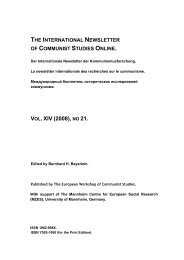11RXNdQ
11RXNdQ
11RXNdQ
You also want an ePaper? Increase the reach of your titles
YUMPU automatically turns print PDFs into web optimized ePapers that Google loves.
want you to feel, as I, the sensation of being seen. For the white man has enjoyed for<br />
three thousand years the privilege of seeing without being seen’ (Sartre 1976a: 7). The<br />
colonial subject constantly oscillates between the two states, internalizing the colonial<br />
ideology of inferiority and being less than fully human – until he, or she, assumes<br />
responsibility and chooses authenticity and freedom. It is for this reason that Black Skin,<br />
White Masks is a liberationist text.<br />
Sartre’s Hegelian training enabled him to recognize that power was a dialectical<br />
phenomenon, that torturer and tortured, racist and victim, colonizer and colonized, the<br />
empowered and disempowered, were locked in a symbiotic relation in which the first<br />
could not escape the consequences of his relations with the second. The split between<br />
colonizer and colonized, internalized by Fanon to provide the kind of Manichaean schizoculture<br />
so forcefully analysed at the beginning of The Wretched of the Earth (1961), is<br />
drawn directly from Sartre’s model in which colonizer and colonized are ‘similarly<br />
strangled by the colonial apparatus, that heavy machine’ (Sartre 1964:51). Caught up in<br />
that system, transformed into an oppressor or torturer, the colonizing subject also finds<br />
himself in a condition of ontological ambivalence: ‘both the organiser and the victim’,as<br />
Fanon put it, ‘of a system that has choked him and reduced him to silence’ (Sartre 1976a:<br />
724; Fanon 1980:10).<br />
IV<br />
Sartre’s insight that the Manichaean system of racism and colonization, apparently<br />
dividing colonizer from colonized, in fact generates dynamic mutual mental relations<br />
between colonizer and colonized which bind them in the colonial drama, was further<br />
elaborated by Albert Memmi in his demonstration that the dialectic also involved what<br />
Hegel had called the ‘excluded middle’: the spectral presence of the liminal, subaltern<br />
figures who slip between the two dominant antithetical categories. Sartre’s response was<br />
to emphasize the dialectical aspect of his own account, suggesting that Memmi saw a<br />
situation where he also saw a system. Sartre stressed the systematic role that racism<br />
plays, so that the economic divisions of the colony are an effect of institutionalized<br />
racism: the white man is rich because he is white. This racial hierarchy, Sartre argued, the<br />
major ideological pivot of colonial ideology, worked by relegating colonial subjects to<br />
the status of subhuman. From this point of view, the constitutional liberation movements<br />
of the nationalist parties were based on nothing more, and nothing less, than the demand<br />
that colonized peoples be given human rights, or, as Fanon puts it, ‘a string of<br />
philosophico-political dissertations on the themes of the rights of peoples to selfdetermination,<br />
the rights of man to freedom from hunger and human dignity, and the<br />
unceasing affirmation of the principle “one man, one vote”’ (Fanon 1965:47). Western<br />
humanism and rights discourse, Sartre argues, had worked by excluding a majority of the<br />
world’s population from the category of the human. The new humanism of Fanon,<br />
Guevara and Castro, and the anti-humanism of Althusser, were essentially founded on the<br />
same colonial problematic: that the racism of colonialism was degrading colonial (or<br />
semi-colonized) subjects to the category of the subhuman. What was required, therefore,<br />
was either to do away with the concept of humanism altogether, or, more positively, to




